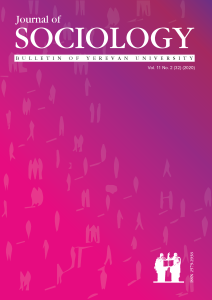Contemporary Approaches to Sociological Reinterpretation of the Functions of Armed Forces
DOI:
https://doi.org/10.46991/BYSU:F/2020.11.2.049Keywords:
Armed forces, social functions of the army, Cold War, modernity and postmodernity, globalizationAbstract
While relatively stable, the functions of the armed forces and the ways of their implementation still undergo certain changes from time to time. This creates difficulties for their theoretical and methodological interpretation, as well as the need to rethink the concepts of the army in military sociology. The late 20th and early 21st centuries are considered by military sociologists to be a key period in terms of changing social roles, mission, functions and structure of the armed forces. The article pays special attention to theoretical approaches to their rethinking in the modern army.
References
Edmunds, T. (2006). What are armed forces for? The changing nature of military roles in Europe. International Affairs, 82(6), 1059․ Doi: https://doi.org/10.1111/j.1468-2346.2006.00588.x
Huntington, S. (1957). The Soldier and the State: The Theory and Politics of Civil–Military Relations, Harvard University Press Massachusetts, Cambridge
Janowitz, M. (1960). The professional soldier. A Social and Political Portrait, Free Press, Glencoe. Doi: https://doi.org/10.2307/1891771
Moskos, Ch., Williams, J. & Segal D. (2000). The Postmodern Military: Armed Forces after the Cold War, 1st Edition, Oxford University press, Oxford
Shaw, M. (2000). The Development of “Common –Risk” Society: A theoretical Overview”, Military and Society in Twenty First Century Europe, A comparative Analysis, Transaction Publishers, 13-26. Doi: https://doi.org/10.4324/9781315124490-3
Shaw, M. (1991). Post Military Society: Militarism, Demilitarization, and War at the end of Twentieth Century, Temple University Press
Beck, U. (1986). “Risk Society Towards a New Modernity”. SAGE publications, US, CA
Berdal, M. (1992). Book Review: Martin Shaw, Post-Military Society: Militarism, Demilitarization and War at the End of the Twentieth Century,Cambridge: Polity Press, Millennium: Journal of International Studies, 21(3), 544–546. Doi: https://doi.org/10.1177/03058298920210030417
Burk, J. (1994). The Military in New Times: Adapting Armed Forces to a Turbulent World, Westview Press, London and New York, 3-6
Aglyan, V. (2015). Mijazgayin hierarkhik haraberutyunneri martahravernery, Noravanq, 21-rd dar, 5(63), Yerevan, 26
Callaghan, J. & Kernic F. (2003). New missions and tasks for the Post-Modern Military. Armed Forces and International Security: Global Trends and Issues, Lit Verlag Munster, 41
Burk, J. (1994). The Military in New Times Adapting Armed Forces to a Turbulent World, Westview Press, London and New York, 7-8
Levy, Y. (2010). The essence of the “Market Army”, Public Administration review, 70(3), 378-389. Doi: https://doi.org/10.1111/j.1540-6210.2010.02152.x
Edmunds, T. (2010). The defence dilemma in Britain, International Affairs, 86(2), 377–394. Doi: https://doi.org/10.1111/j.1468-2346.2010.00887.x
Gadjiev, K. (2003). Geopolitika Kavkaza. Moscow, 8
Fjader, Ch. (2014). The nation-state, national security and resilience in the age of globalization, National Emergency Supply Agency (NESA), Helsinki, Finland, Vol. 2, No. 2, 114–129. Doi: https://doi.org/10.1080/21693293.2014.914771
DiIorio, J. (1992). Feminism and war: Theoretical issues and debates. Reference Services Review, 20(2), 1992, 51–68. Doi: https://doi.org/10.1108/eb049153
Jaquette, J. (2003). Feminism and the Challenges of the “Post-Cold War” World. International Feminist Journal of Politics, 5(3), 331–354. Doi: https://doi.org/10.1080/1461674032000122704
Nye, J. (2017). Soft power: the origins and political progress of a concept. Palgrave Communications, 2. Doi: https://doi.org/10.1057/palcomms.2017.8
Downloads
Published
How to Cite
Issue
Section
License
Copyright (c) 2020 Arevik Hambardzumyan

This work is licensed under a Creative Commons Attribution-NonCommercial 4.0 International License.








